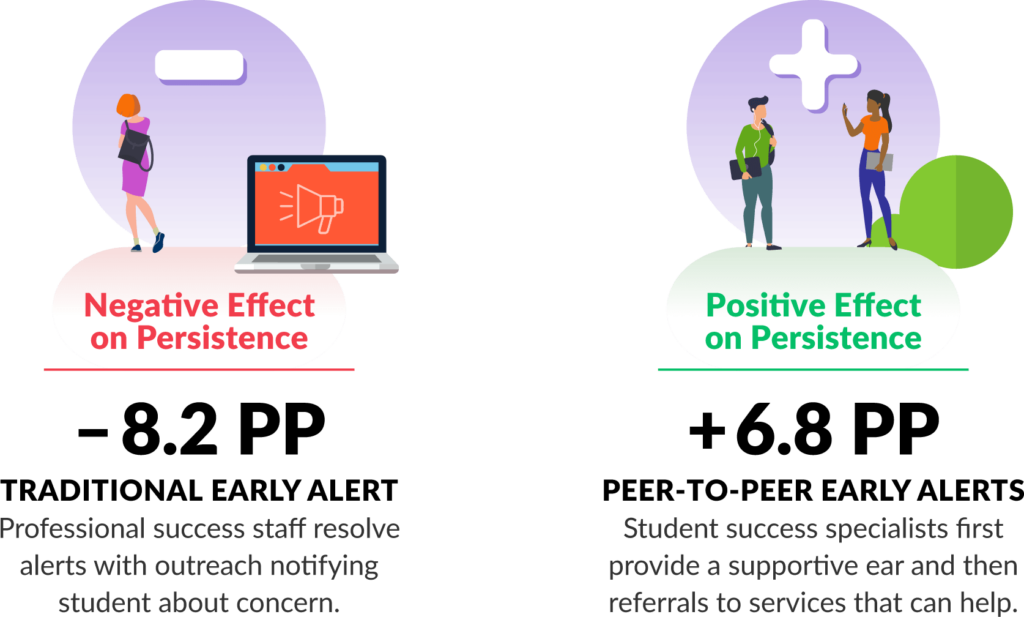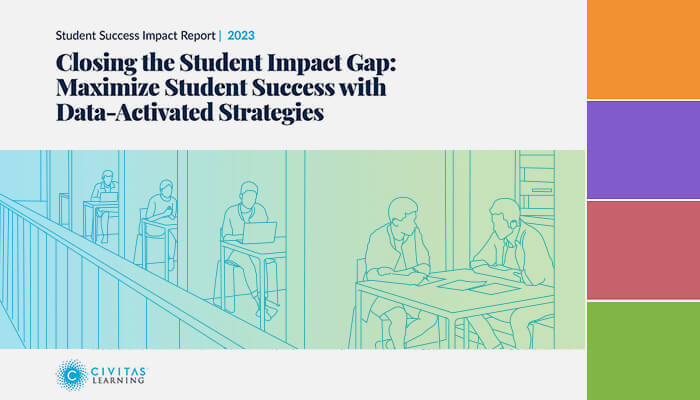
3 Keys to Designing an Effective Early Alert Program
Share this Post
Early alerts are a typical student success practice, and in theory, they’re a positive system to have in place. However, the latest research increasingly suggests that early alert systems can backfire, causing harm to both students and institutions.
Poorly designed early alert programs can discourage students from engaging, overwhelm staff, and perpetuate existing biases. Civitas Learning partner institutions who’ve designed impactful early alert programs use actionable insights to fine-tune what constitutes an appropriate alert and how to address alerts to create a positive impact.
Effective early alert programs are successful by:
Providing Personalized Outreach to Students

The 2023 Civitas Learning Student Success Impact Report demonstrates that when early alert interventions take a one-size-fits-all approach, they fail. Traditional early alert programs lead to a staggering 8.2 percentage point drop in persistence in our analysis.
Using early alerts to only highlight a student’s poor grades may make them feel like they do not belong in college or cannot handle the academic demands. Poorly crafted early alert interventions can lead students to disengage.
The ability to craft alert interventions tailored to each student –considering their identity and unique context– is the first and most important step in optimizing outreach. Our analysis shows that an intentionally designed early alert program with personal and engaging outreach yielded a 6.8 percentage point lift in persistence.
Support teams can better identify which students need immediate attention by utilizing an early alert system that places alerts in the context of other success metrics like persistence prediction. This allows for tailored messaging to personalize engagement.
Recently, a Civitas Learning partner piloted a tailored approach to early intervention with incredibly successful results. This university shifted its early alert outreach from student success professionals sharing generic information to a peer-to-peer model that centers on building relationships and connections. This shift also yielded a 65% response rate from students and increased faculty member participation in submitting alerts by 13% from the previous year.
The success of their program comes from being intentional with their efforts. Rather than sending students generic mass communications, this institution took a personalized approach to communication to encourage engagement and resource usage.
Building Connections to Reduce Bias and Improve Institutional Impact
It may seem like flagging students with multiple class absences or sending an automated message about low grades would be helpful. The reality is that these generalized approaches don’t just fall flat; they can be more harmful than helpful. Early alert systems need thoughtful messaging crafted with intention and sensitivity to be effective and equitable.
An early alert may seem like “just a nudge,” but the wrong wording from an unfamiliar university official can discourage students from getting the support they need. Research shows this is especially true for students from underserved populations, including students of color, where poor outreach can negatively impact their academic performance, sense of belonging, and relationships with faculty and staff.
In our partner institution’s peer-to-peer early alert model, relationship building starts from the first day of classes. It employs students as success specialists to provide outreach that builds connections instead of simply serving as an alert. The student success specialists offer a supportive ear and, when needed, referrals to services that can help.
Proactive engagement, primarily through text messaging, is initiated during the welcome activities for new students. An integrated case management system records every email and text message that students receive, enabling support staff to view the engagement history. This record of interactions provides the staff with the necessary context to craft personalized and authentic outreach messages.
Throughout their first year, students who require assistance are quickly contacted and sent messages that reassure them that someone at the institution cares about them. The messages contain open-ended questions encouraging students to discuss any challenges they may face.
This approach to early alerts aims to improve students’ academic performance, but the primary focus is on helping them overcome problems that can impact their performance.
Is Your Early Alert System Doing More Harm Than Good?
Leveraging Actionable Insights to Effectively Scale Outreach Efforts
Using actionable analytics to move beyond routine data analysis is essential to understanding a student’s journey, identifying predictors of success, and discovering ways to engage and motivate students to stay enrolled and graduate on time. Leaders who monitor institution-specific and student-specific trends can better understand what works and for whom, enabling them to identify impactful student success efforts and make data-informed decisions that positively impact student success rates.
By gaining clear insights into what works for individual students and specific student groups, institutions can be proactive in their strategies versus reactive. Utilizing student-specific actionable insights means teams can be more strategic in designing early alert programs and scale more effectively.
Visibility into which students require support saves time and makes differentiating intervention strategies feasible. For instance, advisors may address alerts for those students with a lower likelihood of persistence. At the same time, peer mentors focus on alerts for those with less risk, ensuring that limited staff resources are efficiently utilized. Matching students with the most impactful approaches and programs also increases positive outcomes. By starting with the interventions that are likely to have the most positive and significant impact, leaders can ensure that resources are utilized most effectively.
Regular efficacy analysis can reveal if you need to change course because your program inadvertently has a harmful effect. With Initiative Analysis, institutions can understand the impact of their early alerts program to invest and adjust to deliver the most impact. Regular efficacy analysis can also signal what approaches need further investment to enhance early intervention programs and elevate their success.
A New Way Forward for Early Alerts
When thoughtfully designed with holistic data and the whole student picture, early alert systems can be just one of many powerful tools in your institution’s approach to student success.
The new way forward for early alerts means rethinking any cookie-cutter approaches and instead considering how to craft an intentional program that’s both sensitive and effective. By offering personalized support, increasing impact, and reducing bias and overwhelm, a well-designed early alert system can positively impact not just students, faculty, and staff.




